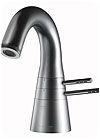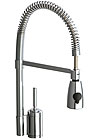
Within the world of residential plumbing, there are few product categories “trendier” than faucets. There are numerous reasons for this, including the focus of their use in kitchens and bathrooms, comparative ease of replacement and relatively low cost of tooling by manufacturers who like to keep our interest alive. For most folks, faucet design means styling, but there is far more going on in this department than a flurry of facelifts and cosmetic makeup. This article will take a look below the skin to see what's new or revived in regard to “engines and bodies.” (Before we get started, let me explain that this discussion will be limited to manual faucets only - we'll save discussions of shower valves and electronic faucets for future coverage.)
UNDER THE HOOD - NEW VALVING MECHANISMS
For most of our plumbing lives, any discussion concerning the types of valving mechanisms used in faucets has been short and sweet. We had two-handle and single-lever types - and that was about it. Today, we are seeing other options emerge, some involving other control movements. The joystick type, for instance, is just a short step away from the single lever variety in function. It differs primarily in its use of a “single plane” operating motion, and is most often equipped with a vertical lever (that is a key visual identifier to distinguish it from single-lever models, by the way). Like single-lever types, the joystick mechanism controls both volume and temperature with a single handle.(Note: technically, the familiar ball mechanism is a joystick type, though it has most often been equipped with horizontally oriented handles. Most of the more recent joystick offerings are ceramic types, however, utilizing a vertical handle.)Another new type of faucet cartridge is the “flo-thru” configuration in which water enters the bottom and is discharged up through a hollow stem on top (rather than being routed back down into the faucet body like conventional ones). There are mixing versions of this concept, as well as individual hot and cold types. Both versions are typically controlled by one or two small levers off the side of the faucet body or spout support. Note that mixing types provide a “cycling” type of control, meaning that they do not include volume adjustment (after turning on, the rotating lever motion changes the temperature - from cold, through mixed, to hot - at a constant flow rate).(Note: there are some faucets that have the same flo-thru appearance (with a lever on the side) that also provide volume control. This is actually accomplished with a small diameter single-lever cartridge that discharges water down and then back up a side passage to connect with the spout. The lever on these types moves up and down (for the on-off and volume control functions) in addition to rotating (for temperature selection).)
There are also new types of two-handle mechanisms. Among them are individual hot and cold lever cartridges that provide control with separate “sticks.” (Interestingly, this type of control was prophesied by Cornell professor Alexander Kira 30 years ago, in his classic ergonomic study, “The Bathroom.”)
NEW AND REVIVED FAUCET CONSTRUCTIONS
Now that we've taken a quick look at what's new in faucet engines, let's see what's up with innovations in the chassis and body departments. Some of the more interesting examples are faucet types we didn't find in residential faucet catalogs until recent years:
The popularity of commercial kitchen components for home use keeps expanding the scope of categories included. Pot fillers have grown from a fringe option to rather common status today, with most high-end faucet lines offering one or more models. The idea here is to have a dedicated faucet for delivering water (cold only) directly to what you're cooking on the range top. Most such faucets are equipped with a double-arm spout to allow a long reach. Initially, most were mounted on the wall adjacent to the stove, but more recently, deck-mounted types have been added (the latter providing more installation flexibility since they do not require opening the wall). Many pot fillers are equipped with both inlet and outlet valves, the reason for which may not always be clear to consumers. Here's why they are built that way: any time you have what is called a “dynamic seal” (one that is subject to movement, friction and wear) you need to avoid subjecting that joint to constant line pressure. That's the protection you get from the inlet valve - you can shut off the pressure ahead of the pivoting spout joints. Otherwise, with a valve positioned only at the end of the spout assembly, any leaking would be constant rather than intermittent (happening only when the faucet is actually in use). Frankly, I suspect that consumers turn off the inlet valve about as often as they shut off the supplies to their washing machine after each use. Though the double-valve arrangement is most common, there are models available that provide just the inlet valve. There is also a type that has a telescoping spout instead of the double pivoting arrangement (also equipped with just an inlet valve).

Chances are, you won't find this commercial kitchen émigré under its original name in many residential faucet catalogs. And most often it won't look exactly the same, either. But the lineage is pretty clear in most cases. In its original restaurant form, a pre-rinse is a dedicated faucet used to spray solids off of dishes and utensils before they are slid on racks into a pass-thru dishwasher. The sprayhead is fed by a hose inside a high gooseneck spring to allow easy movement and aim by the user. The water controls are typically hot and cold valves on a wall or deck-mount faucet body. The lever on the sprayhead turns the spray on and off, and since it can be turned off at the end of the hose, some codes require a vacuum breaker. That's what a pre-rinse faucet is all about in its original form. Though the convenience of a spray function caught the eye of designers and consumers, the product clearly needed “domesticating” for residential use. For starters, it had to be converted into a multi-function sink faucet rather than a dedicated one (it had to serve as your everyday faucet, not just something used for spraying). That meant that the sprayhead needed to be a diverter type providing both full-flow (either aerated or laminar) and spray options - but no shut-off. (Note: there are also models that provide a conventional spout in addition to the spring-hose arrangement, and since such faucets are equipped with an internal diverter mechanism, the sprayhead discharges a spray only (shutting off like the side spray of a conventional faucet). Next, many manufacturers felt the height and heft of the spring needed toning down, so many residential types are smaller - and there is a type that uses no spring at all, simply sheathing the hose within a high-arcing spout. A “parking feature” is also common, taking the form of a horizontal arm with a clip or collar to engage the sprayhead, acting to stabilize the sprayhead when not being held in the user's hand.)
The form of the faucet body and type of valving controls are other aspects of pre-rinse faucet design that have been given a residential makeover. Most have more stylish deck-mounted bodies equipped with single-lever or joystick cartridges. There are also modular types in which the spout is mounted separately from the valving component.

This is a revival category that has its roots in Victorian/Edwardian faucet construction and styling. A lot of folks like it because of its “authentic” period form, the hallmark being the raised body with clearance below. Some feel that the “ultimate purist” version of a bridge faucet needs to include offset fittings for the inlets. Though there is no longer a functional requirement for these parts (originally designed to adjust to dimensional variations in deck drillings), they are often kept in the act simply because “they look like they should be there.”
Probably the biggest challenge during this current revival era of bridge faucet popularity is how you accommodate a side spray. The original bridge faucets didn't have them. In trying to marry this grand old design with today's consumer druthers for a spray, there is a problem. With conventional types of faucet construction, whether deckmount or concealed, there is a place to locate a spray diverter mechanism, and more importantly, a way to route the water down below the deck to connect to the hose. With the typical bridge faucet configuration, the body is up in the air above the deck, so how the heck do you connect a hose?
Earlier answers to this challenge ranged from: (1) offering no spray, (2) adding a third post under the middle of the body and (3) teeing a spray hose off the hot or cold supply feeding the faucet. While some customers accepted one or more of these options, others kept pushing for better solutions. The ideal one they voiced would be an authentic two-post design that could somehow be equipped with a side spray delivering adjustable mixed temperature water. This type is now available in a couple of versions.
One approach has a diverter located inside the faucet body or attached to one of the inlet shanks, and a means of routing spray water down through a concentric passage on one supply side. The other uses a dedicated mixing valve, with its own handle, located next to the spray nest (independent from the faucet). With this latter type, the faucet doesn't have to be turned on for the spray to be used.
